NCERT Solutions for Class 8 Maths - Direct and Inverse Proportions - 1
| Table of contents |

|
| Try These(Page No. 132) |

|
| Think, Discuss and Write |

|
| Exercise 11.1 |

|
| Try These(Page No. 139) |

|
| Exercise 11.2 |

|
| Do This(Page No. 143) |

|
Try These(Page No. 132)
Q1: Observe the following tables and find if x and y are directly proportional.
i.e. Each ratio is the same.
∴ x and y are directly proportional
i.e. All the ratios are not the same.
∴ x and y are not directly proportional.
i.e. All the ratios are not the same.
∴ x and y are not directly proportional.
Q2: Principal = Rs 1000, Rate = 8% per annum. Fill in the following table and find which type of interest (simple or compound) change in direct proportion with time period.
Solution. Case of Simple Interest [P = Rs 1000, r = 8% p.a.]
∵ In each case the ratio is the same.
∴ The simple interest changes in direct proportion with time period.
Case of Compound Interest [P = Rs 1000, r = 8% p.a.]
∵ is not the same in each case.
∴ The compound interest does not change in direct proportion with time period.
Think, Discuss and Write
Question: If we fix time period and the rate of interest, simple interest changes proportionally with principal. Would there be a similar relationship for compound interest? Why?
Solution. For simple interest,
Since rate and time period are constant, then SI changes directly according to P.
Thus, the simple interest changes in direct proportion with the principal.
For compound interest,
Since, rate and time period are constant, then
i.e. CI changes with P.
Thus, the compound interest also changes directly in proportion with principal.
Exercise 11.1
Q1: Following are the car parking charges near a railway station uptoCheck if the parking charges are in direct proportion to the parking time.
Sol: We have,Since
∴ The parking charges are not in direct proportion with the parking time.
Q2: A mixture of paint is prepared by mixing 1 part of red pigments with 8 parts of base. In the following table, find the parts of base that need to be added.Sol: Let the red pigment be represented by x1, x2, x3, … and the base represented by y1, y2, y3, ... .
As the base increases, the required number of red pigments will also increase.
∴ The quantities vary directly.
Now
Thus, the required parts of base are: 32, 56, 96 and 160.
Q3: In question 2 above, if 1 part of a red pigment requires 75 mL of base, how much red pigment should we mix with 1800 mL of base?
Sol:
Here, x1 = 1, y1 = 75 and y2 = 1800
Thus, the required red pigments = 24 parts.
Q4: A machine in a soft drink factory fills 840 bottles in six hours. How many bottles will it fill in five hours?
Solution:
| Number of bottles filled | Number of hours |
| 840 | 6 |
| x | 5 |
For more number of hours, more number of bottles would be filled. Thus given quantities vary directly.
Thus, the required number of bottles = 700
Q5: A photograph of a bacteria enlarged 50,000 times attains a length of 5 cm as shown in the diagram. What is the actual length of the bacteria? If the photograph is enlarged 20,000 times only, what would be its enlarged length?
Solution: Let the actual length of the bacteria = x cm
| Number of times photograph enlarged | Length (in cm) |
| 1 | x |
| 50,000 | 5 |
The length increases with an increment in the number of times the paragraph enlarged.
∴ It is a case of direct proportion
Again,
Q6: In a model of a ship, the mast is 9 cm high, while the mast of the actual ship is 12 m high. If the length of the ship is 28m, how
long is the model ship?
Sol: Let the required length of the model of the ship = x cm
We have:
| Length of the ship | Height of the mast |
| 28 | 12 |
| x | 9 |
Since, more the length of the ship, more would be the length of its mast.
∴ It is a case of direct variation.
Thus, the required length of the model = 21 cm\
Q7: Suppose 2 kg of sugar contains 9 * 106 crystals. How many sugar crystals are there in
(i) 5 kg of sugar?
(ii) 1.2 kg of sugar?
Sol: Let the required number of sugar crystals be x in 5 kg of sugar.
We have:
Since, more the amount of sugar, more would be the number of sugar crystals.
∴ It is a case of direct variation.
Thus, the required number of sugar crystals = 2.25 * 107
(ii) Let the number sugar crystals in 1.2 kg of sugar be y.
∴ We have:
∴ For a direct variation,
Q8: Rashmi has a road map with a scale of 1 cm representing 18 km. She drives on a road for 72 km. What would be her distance covered in the map?
Sol: Let the required distance covered in the map be x cm.
We have:
Since, it is a case of direct variation,
Thus, the required distance on the map is 4 cm.
Q9: A 5 m 60 cm high vertical pole casts a shadow 3 m 20 cm long. Find at the same time(i) the length of the shadow cast by another pole 10 m 50 cm high and (ii) the height of a pole which casts a shadow 5 m long.
Sol: (i) Let the required length of shadow be x cm.
We have:
As the height of the pole increases the length of its shadow also increases in the same ratio. Therefore, it is a case of direct variation.
Thus, the required length of the shadow = 600 cm or 6 m
(ii) Let the required height of the pole be y cm.
∴ We have:
Since, it is a case of direct variation,
Thus, the required height of the pole = 875 cm or 8 m 75 cm
Q10: A loaded truck travels 14 km in 25 minutes. If the speed remains the same, how far can it travel in 5 hours?
Sol: Since the speed is constant,
∴ For longer distance, more time will be required.
So, it is a case of direct variation.
Let the required distance to be travelled in 5 hours (= 300 minutes) be x km.
We have:
| Distance (in km) | Time (in minutes) |
14 x | 25 300 |
∴ The required distance = 168 km.
Try These(Page No. 139)
Ques: Observe the following tables and find which pair of variables (here x and y) are in inverse proportion.
(i)
x | so | 40 | 30 | 20 |
y | 5 | 6 | 7 | S |
(ii)
x | 100 | 200 | 300 | 400 |
y | 60 | 30 | 20 | 15 |
(iii)
x | 90 | 60 | 45 | 30 | 20 | 5 |
y | 10 | 15 | 20 | 25 | 30 | 35 |
Sol:
(i) ∵ x1 = 50 and y1 = 5 ⇒ x1y1 = 50 * 5 = 250
x2 = 40 and y2 = 6 ⇒ x2y2 = 40 * 6 = 240
x3 = 30 and y3 = 7 ⇒ x3y3 = 30 * 7 = 210
x4 = 20 and y4 = 8 ⇒ x4y4 = 20 * 8 = 160
Also 250 ≠ 240 ≠ 210 ≠ 160 or
x1y1 ≠ x2y2 ≠ x3y3 ≠ x4y4
∴ x and y are not in inverse proportion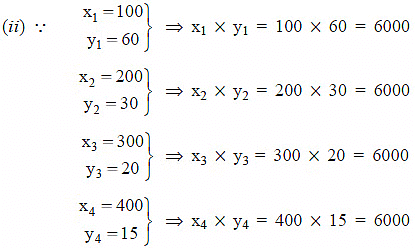 and x1y1 = x2y2 = x3y3 = x4y4
and x1y1 = x2y2 = x3y3 = x4y4
∴ x and y are in inverse proportion.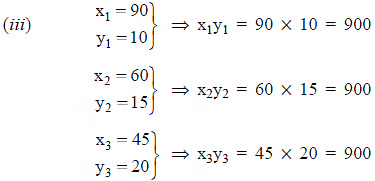
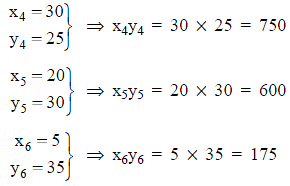 and x1y1 = x2y2 = x3y3 ≠ x4y4 ≠ x5y5 ≠ x6y6
and x1y1 = x2y2 = x3y3 ≠ x4y4 ≠ x5y5 ≠ x6y6
∴ x and y are not in inverse variation.
Exercise 11.2
Q1: Which of the following are in inverse proportion?
(i) The number of workers on a job and the time to complete the job.
(ii) The time taken for a journey and the distance travelled in a uniform speed.
(iii) Area of cultivated land and the crop harvested.
(iv) The time taken for a fixed journey and the speed of the vehicle.
(v) The population of a country and the area of land per person.
Sol:
REMEMBER
If an increase in one quantity brings about a corresponding decrease in the other and vice versa, then the two quantities vary inversely.
(i) If number of workers are increased then time to complete the job would decrease.
∴ It is a case of inverse variation.
(ii) For longer distance, more time would be required.
∴ It is not a case of inverse variation
(iii) For more area of land, more crops would be harvested.
∴ It is not a case of inverse variation.
(iv) If speed is more, time to cover a fixed distance would be less.
∴ It is a case of inverse variation.
(v) For more population, less area per person would be required.
∴ It is a case of inverse variation.
Q2: In a television game show, the prize money of Rs 1,00,000 is to be divided equally amongst the winners. Complete the following table and find whether the prize money given to an individual winner is directly or inversely proportional to the number of winners?
Number of winners | 1 | 2 | 4 | 5 | 8 | 10 | 20 |
Prize for each winner (in Rs) | 1,00,000 | 50,000 |
| ... | — | ... | — |
Sol: If more the number of winners, less is the prize money.
∴ It is a case of inverse proportion.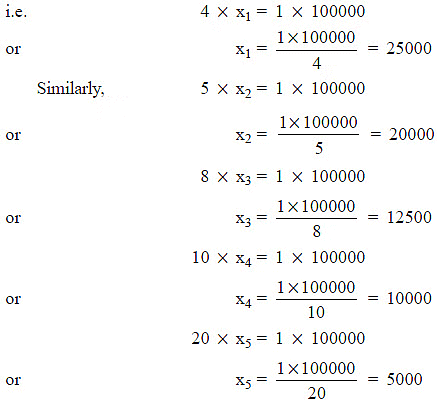
Thus, the table is completed as under:
Number of winners | 1 | 2 | 4 | 5 | 8 | 10 | 20 |
Prize for each winner (in Rs) | 1,00,000 | 50,000 | 25,000 | 20,000 | 12,500 | 10,000 | 5,000 |

| Number of spokes | 4 | 6 | 8 | 10 | 12 |
| Angle between a pair of consecutive spokes | 90o | 60o | .... | .... | .... |
(i) Are the number of spokes and the angles formed between the pairs of consecutive spokes in inverse proportion?
(ii) Calculate the angle between a pair of consecutive spokes on a wheel with 15 spokes.
(iii) How many spokes would be needed, if the angle between a pair of consecutive spokes is 40°?
Sol: (i) Obviously, more the number of spokes, less is the measure of angle between a pair of consecutive spokes.
∴ It is a case of inverse variation.
Thus,
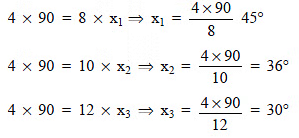
Thus, the table is completed as under
Number of spokes | 4 | 6 | 8 | 10 | 12 |
Angle between a pair of consecutive spokes | 90° | 60° | 45° | 36° | 30° |
(ii) Let the required measure of angle be x°.

(iii) Let required number of spokes be n.

∴ The required number of spokes = 9
Q4: If a box of sweets is divided among 24 children, they will get 5 sweets each. How many would each get, if the number of the children is reduced by 4?
Sol: Reduced number of children = 24 – 4 = 20
Since, more the number of children, less is the quantity of sweets.
∴ It is a case of inverse variation.
i.e. 24 * 5 = 20 * x
or 
∴ Each student will get 6 sweets.
Q5: A farmer has enough food to feed 20 animals in his cattle for 6 days. How long would the food last if there were 10 more animals in his cattle?
Sol: Number of animals added = 10
∴ Now, the total number of animals = 10 + 20 = 30
For more number of animals, the food will last less number of days.
∴ It is a case of inverse variation.
Thus, we have
30 * x = 20 * 6
or 
Therefore, the food will now last for 4 days.
Q6: A contractor estimates that 3 persons could rewire jasminder’s house in 4 days. If, he uses 4 persons instead of three, how long should they take to complete the job?
Sol: More is the number of persons, less is the time to complete job.
∴ It is a case of inverse variation.
| Number of persons | Number of days to complete the wiring job |
3 4 | 4 x |
∴ 3 * 4 = 4 * x
or x = 3 * 4 = 3
∴ The required number of days = 3
Q7: A batch of bottles were packed in 25 boxes with 12 bottles in each box. If the same batch is packed using 20 bottles in each box, How many boxes would be filled?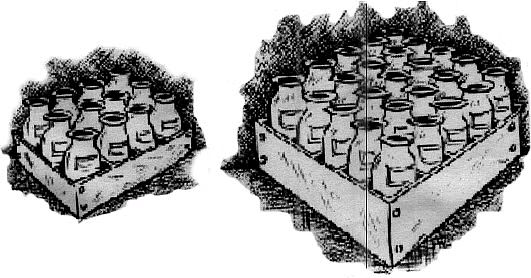 Sol: Let the number of boxes required = x
Sol: Let the number of boxes required = x
We have:
| Number of bottles in a box | Number of boxes |
12 | 25 x |
Since, more the number of bottles in a box, lesser will be the number of boxes required to be
filled.
∴ It is a case of inverse variation.
i.e.
Thus, the required number of boxes = 15
Q8: A factory requires 42 machines to produce a given number of articles in 63 days. How many machines would be required to produce the same number of articles in 54 days?
Sol: Let the number of machines required be x.
We have:
Number of machines | Number of days |
42 | 63 |
X | 54 |

or
Thus, the required number of machines = 49
Q9: A car takes 2 hours to reach a destination by travelling at the speed of 60 km/h. How long will it take when the car travels at the speed of 80 km/h?
Sol: More the speed, lesser the number of hours to travel a fixed distance.
∴ It is a case of inverse variations.
Speed (km/h) | Time taken to cover the fixed distance |
60 | 2 |
80 | X |

Thus the required number of hours = 
Question 10. Two persons could fit new window in a house in 3 days.
(i) One of the persons fell ill before the work started. How long would the job take now?
(ii) How many persons would be needed to fit the windows in one day?
Sol: (i) Let the time taken by the remaining persons to complete the job be x.
∵ 2 persons – 1 person = 1 person and lesser the number of person, more will be the number of days to complete the job.
∴ It is a case of inverse proportion.
We have:
Number of persons | Number of days |
2 | 3 |
1 | X |

∴ 1 person will complete the job in 6 days.
(ii) We have
Number of persons | Number of days |
2 | 3 |
X | 1 |

∴ 6 persons will be required to complete the job in 1 day.
Q11: A school has 8 periods a day each of 45 minutes duration. How long would each period be, if the school has 9 periods a day, assuming the number of school houres to be the same?
Sol: For 9 periods, let the duration per period be x minutes.
∴ We have:
Number of periods | Duration of a period (in minutes) |
8 9 | 45 X |
For a fixed duration, more the periods, lesser will be the duration of one period.
∴ It is a case of inverse proportion.
i.e. 8 * 45 = 9 * x
Thus, the required duration per period = 40 minutes.
Do This(Page No. 143)
Q1: Take a sheet of paper. Fold it as shown in the figure. Count the number of parts and the area of a part in each case.
 Tabulate your observations and discuss with your friends. Is it a case inverse proportion? Why?
Tabulate your observations and discuss with your friends. Is it a case inverse proportion? Why?| Number of parts | 1 | 2 | 4 | 8 | 16 |
| Area of each part | area of the paper | 1/2 the area of the paper | .... | .... | .... |
Solution:
| Number of parts → | 1 | 2 | 4 | 8 | 16 |
| Area of one part → | Area of the | 1/2 Area of the paper | 1/4 Area of the paper | 1/8 Area of the paper | 1/16 Area of the paper |
Here, more the number of parts, lesser is the area of each part.
∴ It is a case of “inverse proportion”.
Q2: Take a few containers of different sizes with circular bases. Fill the same amount of water in each container. Note the diameter of each container and the respective height at which the water level stands. Tabulate your observations. Is it a case of inverse proportion?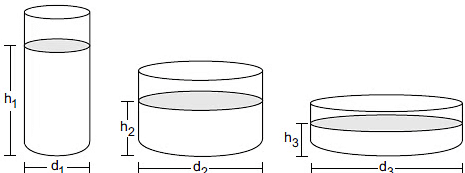
Diameter of container (in cm) |
|
|
|
Height of water level (in cm) |
|
|
|
Sol:
Diameter of container (in cm) | d1 | d2 | d3 |
Height of water level (in cm) | h1 | h2 | h3 |
Here, lesser the diameter, more is the level of water in the container.
∴ It is a case of inverse proportion.
|
94 videos|549 docs|42 tests
|
FAQs on NCERT Solutions for Class 8 Maths - Direct and Inverse Proportions - 1
| 1. What is direct proportion and how is it represented mathematically? |  |
| 2. How can we determine if two quantities are in inverse proportion? |  |
| 3. Can a quantity be in both direct and inverse proportion at the same time? |  |
| 4. How can direct and inverse proportions be applied in real-life situations? |  |
| 5. How can we solve problems involving direct and inverse proportions effectively? |  |





















